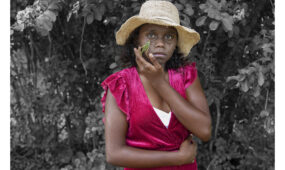'Blockbuster Betty' shared passion for art
InReview

Betty Churcher, one of Australia’s most accomplished and ground-breaking arts administrators, has died aged 84 after a brief illness.
Churcher, who died peacefully on Monday night surrounded by her four sons, was the first woman to be appointed director of the National Gallery of Australia, where she earned a reputation for bringing some of the world’s best art to local audiences through temporary exhibitions.
The success of the ventures, which attracted hundreds of thousands of visitors to the Canberra gallery, also earned her the nickname “Betty Blockbuster”.
Churcher wanted everyone else to experience art in the same way she first did as a seven-year-old.
Whether through blockbuster exhibitions, television shows or her drawing notebooks, she always wanted to share the feeling she experienced during a visit to the Queensland Art Gallery as a child.
It was there she found her first love: Blandford Fletcher’s painting Evicted.
“I’m sure that my enthusiasm for special exhibitions when I was an art gallery director had a lot to do with that first encounter with art,” she wrote in Notebooks.
“I wanted people, especially schoolchildren, to see and feel the magic of art.”
Churcher was born in Brisbane in 1931 in the midst of the Great Depression.
During her final weeks, she described her life as busy, long, fruitful and with no regrets.
She began drawing at an early age as a way of “creating order in a confusing world”, and later remembered being surprised to discover other children didn’t necessarily have the same natural ability to draw.
After a private school education enabled by a bequest from her grandmother, Churcher won a position to study art in England.
She graduated from the Royal College of Art in 1956 with a first class pass, the drawing prize, a travelling scholarship and a husband, fellow painter Roy Churcher.
The couple returned to Australia intending to stay six months, but Roy fell in love with the country.
They had four sons between 1959 and 1966 – Ben, Paul, Peter and Tim. Churcher decided from the start to give away painting when she became a mother.
“I know that my babies sapped my emotional energy and artistic ambitions,” she wrote in 2011. Nevertheless, she didn’t regret the decision.
Although she did not paint seriously again. In 1971 she returned to her early career as an art teacher, this time at tertiary institutions.
Undertaking a masters degree led Churcher to realise that what she really ought to be doing was working in a gallery and in 1987 she was appointed director of the Art Gallery of Western Australia.
Churcher made history three times during her career: she was the first female head of a tertiary institution, first female director of a state gallery and the first woman to be appointed director of the National Gallery of Australia.
Initially she wasn’t interested in the NGA job, feeling she had unfinished business in the west.
But it was her approach to transforming the gallery’s public appeal and significance as a cultural exhibition that cemented her place in Australia’s arts history – and the nickname.
Before Churcher’s tenure, the gallery’s major exhibitions were largely “packages” curated from other institutions around the world.
That changed in 1992 with the Rubens and the Italian Renaissance exhibition, curated by the NGA’s own David Jaffe.
Churcher described it as the best exhibition Canberra had ever seen and recalled queues stretching hundreds of metres out of the gallery every day.
It was the first of a dozen blockbuster exhibitions that brought together the best of art collections from around the world.
She took the attitude “what we couldn’t afford to buy, we could borrow – and we could borrow the very best”.
Every exhibition aimed to arouse the curiosity in the viewer Churcher recalled from her own childhood.
Churcher left the gallery in 1997 but did not retire from the public consciousness.
She hosted television programs about art – Take Five and Hidden Treasures – and published notebooks of her drawings and recollections about her favourite paintings.
The latter project started when her sight began deteriorating in the mid-2000s and she was afraid of losing the joy of drawing, painting and observing the world.
“The thought of near-total blindness plunged me into black despair,” she said.
Since childhood, sketching paintings was the best way Churcher found of embedding them in her memory, so she began a tour of the world’s galleries to revisit her favourites.
Her aim, as ever, was to bring her enthusiasm for the great works to a wider public.

Get InReview in your inbox – free each Saturday. Local arts and culture – covered.
Thanks for signing up to the InReview newsletter.
“Everything I do, whether it’s doing a blockbuster exhibition or a book, is towards educating, getting people curious to really look at a work of art as they may never have looked before,” she said recently.
“That obsession has just jerked me through life to this point.”
Support local arts journalism
Your support will help us continue the important work of InReview in publishing free professional journalism that celebrates, interrogates and amplifies arts and culture in South Australia.
Donate Here





Comments
Show comments Hide comments